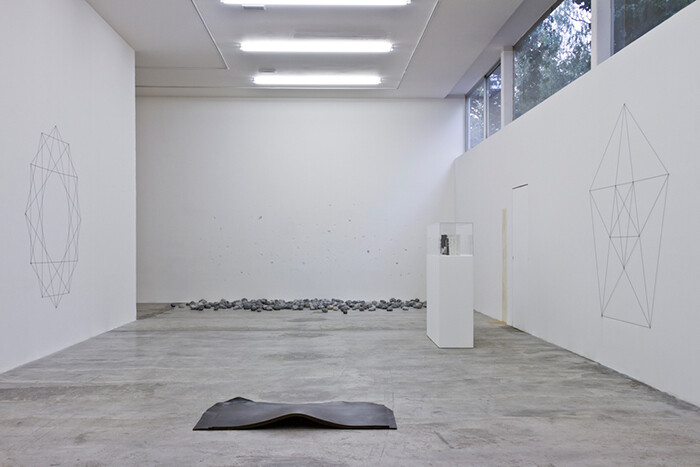With Katinka Bock, Etienne Chambaud, Hernán Díaz, Fabien Giraud, Karl Holmqvist, The Institute for Figuring, and Nicholas Mangan.
In the keynote essay for “Sinking Islands,” on view at LABOR, Mexico City, curator Vincent Normand provocatively asks, “What would be an exhibition of things flat-out alone, requiring the presence of no one?” We subjects of modernity, it would seem, are the problem this group exhibition seeks to critique, less in directly attacking the discursive means by which we have named and, thus, delimited the world, than by presenting objects that attempt radical breaks from signification, dipping beneath semiological horizons by weight of material intransigence. On account of their resistance to making sense for us, these objects assert a non-anthropocentricity that supposedly demands a self-othering, a becoming-savage of us exegetes. While Normand’s rhetorically encumbered text claims to depart from the promise of Utopia that, in cases like Thomas More, once anchored this topographical conceit, his wish for an insular thingness, in “the ocean of signs,” offers, at best, a cogent prompt of the exhibition’s works; and, at worst, a call-to-withdrawal befitting the conservative position of this cultural moment.
“Sinking Islands” takes form as both an exhibition and takeaway book, the latter of which shares a table, at the gallery entrance, with a caveat of an artwork: Etienne Chambaud’s cube-shaped aquarium of two blind Mexican fish (The Bind Box, 2003). Indeed, Karl Holmqvist’s five string mandalas, which buttress the long gallery, seem designed not for the eyes but for that niggling part of the flesh that calls for a spiritual enclosure. Katinka Bock’s Atlantic Corners (2011) offer indices of absent bodies, marring a Nauman-ready corner with wall-glued beach sand and, in another case, shadowing a gallery door.
Nicholas Mangan’s three works appear to share Normand’s debt to speculative realism, literalizing what philosopher Quentin Meillassoux terms an arche-fossil, said to precede the emergence of biological—and, hence, thinking—life. A World Undone (Protolith) (2012) complements and elaborates upon Bock’s sand works, transforming a shallow-relief heap of zircon dust into a microcosm of a mountain—a disorientation that assumes cosmic scale, in an accompanying video, as airborne dust swirls and falls at the digitally-assisted pace of geologic time. The question remains, however, as to whether Normand’s philosophical propositions aesthetically follow from materials less illustrative of his expressly archaeological concerns.
The curator’s willed “unrelation between things and categories of discourse” becomes still less tenable in the case of Etienne Chambaud’s Lapidation Piece (2012), comprising a wall scarred by the stones scattered in front of it, each carved with a character from the artist’s name and the work’s title, year, material, dimensions. Perhaps these inscriptions could be taken as re-identifications of signifier with referent, through a heavy-handed enactment of linguistic concretion. It would strain credibility, however, to ascribe such acts of re-enchantment more to a neo-primitivist impulse than to the type of closed-loop conceptualism that Chambaud, as an artist, habitually mines. As a negative exemplar of the exhibition’s overarching intent, this work needs not a single human being—however modern or savage—beyond the author himself.





